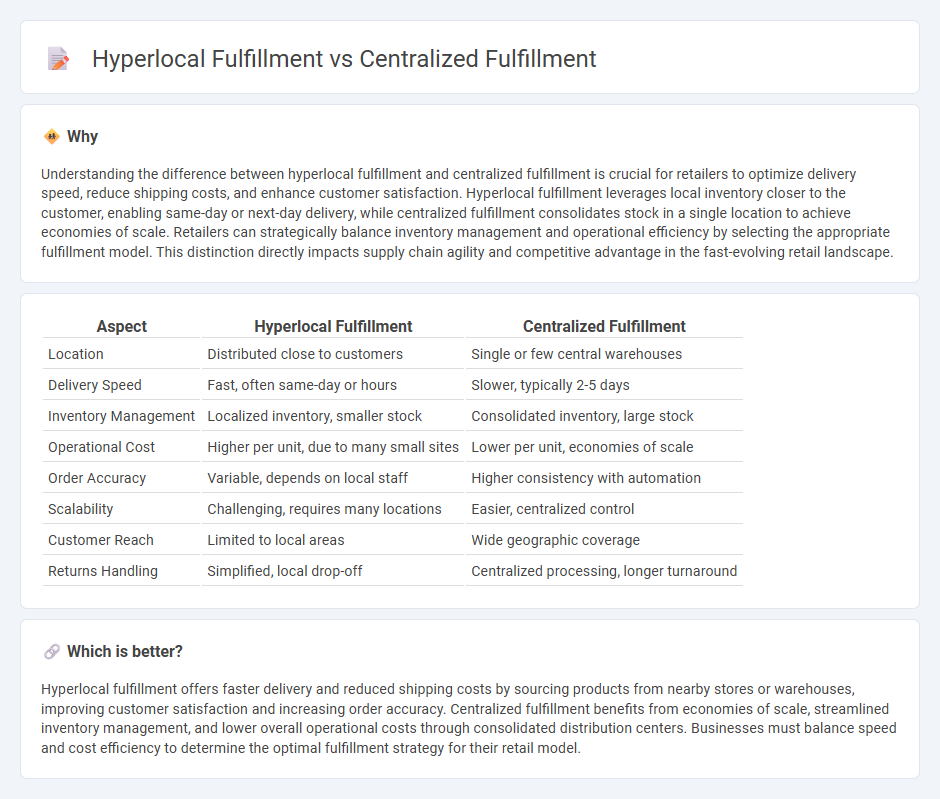
Hyperlocal fulfillment leverages local warehouses and stores to expedite delivery, minimizing shipping times and enhancing customer satisfaction in specific geographic areas. Centralized fulfillment consolidates inventory in large, singular distribution centers to optimize operational efficiency and reduce overhead costs. Explore how each fulfillment strategy impacts retail performance and customer experience.
Why it is important
Understanding the difference between hyperlocal fulfillment and centralized fulfillment is crucial for retailers to optimize delivery speed, reduce shipping costs, and enhance customer satisfaction. Hyperlocal fulfillment leverages local inventory closer to the customer, enabling same-day or next-day delivery, while centralized fulfillment consolidates stock in a single location to achieve economies of scale. Retailers can strategically balance inventory management and operational efficiency by selecting the appropriate fulfillment model. This distinction directly impacts supply chain agility and competitive advantage in the fast-evolving retail landscape.
Comparison Table
| Aspect | Hyperlocal Fulfillment | Centralized Fulfillment |
|---|---|---|
| Location | Distributed close to customers | Single or few central warehouses |
| Delivery Speed | Fast, often same-day or hours | Slower, typically 2-5 days |
| Inventory Management | Localized inventory, smaller stock | Consolidated inventory, large stock |
| Operational Cost | Higher per unit, due to many small sites | Lower per unit, economies of scale |
| Order Accuracy | Variable, depends on local staff | Higher consistency with automation |
| Scalability | Challenging, requires many locations | Easier, centralized control |
| Customer Reach | Limited to local areas | Wide geographic coverage |
| Returns Handling | Simplified, local drop-off | Centralized processing, longer turnaround |
Which is better?
Hyperlocal fulfillment offers faster delivery and reduced shipping costs by sourcing products from nearby stores or warehouses, improving customer satisfaction and increasing order accuracy. Centralized fulfillment benefits from economies of scale, streamlined inventory management, and lower overall operational costs through consolidated distribution centers. Businesses must balance speed and cost efficiency to determine the optimal fulfillment strategy for their retail model.
Connection
Hyperlocal fulfillment leverages local inventory near customers for rapid delivery, while centralized fulfillment utilizes large warehouses to optimize inventory management and reduce costs. Integrating both approaches enhances retail efficiency by combining speed and scale, enabling businesses to meet diverse customer demands effectively. Data-driven inventory allocation and real-time tracking systems create seamless coordination between hyperlocal and centralized fulfillment networks.
Key Terms
Inventory Management
Centralized fulfillment relies on a single, large warehouse that consolidates inventory, streamlining stock control and reducing storage costs but potentially increasing shipping times and limiting responsiveness to local demand fluctuations. Hyperlocal fulfillment distributes inventory across multiple smaller locations closer to end customers, enhancing delivery speed and accuracy but complicating inventory tracking and increasing operational complexity. Explore the nuances and best practices of inventory management in both fulfillment models to optimize your supply chain strategy.
Delivery Speed
Centralized fulfillment relies on a single, large distribution center which often results in longer delivery times due to greater distances between warehouses and customers. Hyperlocal fulfillment operates through multiple smaller hubs closer to end consumers, significantly reducing delivery speed and enabling same-day or even one-hour deliveries. Explore the detailed advantages of each approach to optimize your delivery strategy effectively.
Distribution Network
Centralized fulfillment relies on a few large warehouses strategically placed to serve wide geographic areas, optimizing inventory management and reducing overall storage costs. Hyperlocal fulfillment uses numerous smaller, local hubs to enable faster delivery times and better meet immediate consumer demand within specific neighborhoods. Explore how evolving distribution networks impact retail efficiency and customer satisfaction.
Source and External Links
Centralized or Decentralized Fulfillment? - PFS Commerce - Centralized fulfillment involves managing inventory and order processing from a single location, simplifying inventory planning and reducing operational costs, often suited for small retailers with low order volumes, while offering a unified omnichannel brand experience.
Centralized vs. De-Centralized Fulfillment - NanoFulfillment - Centralized fulfillment means storing all inventory in one major hub serving a large region, contrasting with decentralized fulfillment that uses multiple smaller warehouses closer to customers for faster delivery and scalability.
What Are the Pros and Cons of Centralized and Decentralized ... - Centralized distribution consolidates logistics in one main hub responsible for inventory management and shipping, leading to lower storage costs and simpler warehouse management but potentially longer delivery distances to customers.
 dowidth.com
dowidth.com